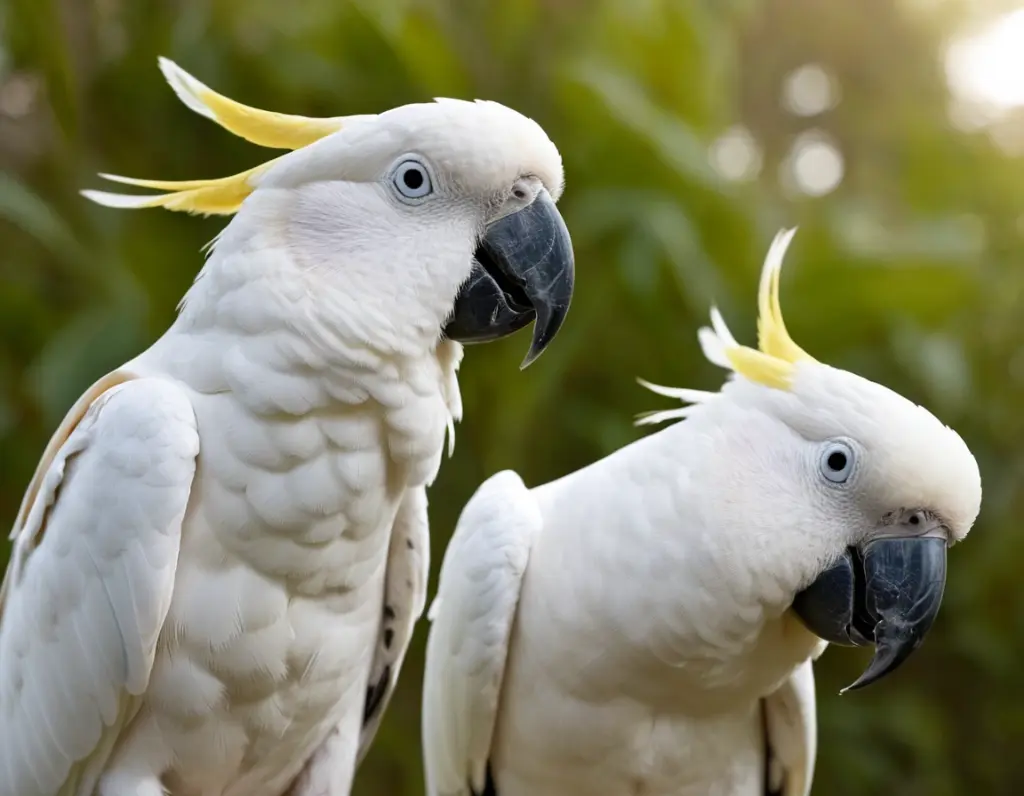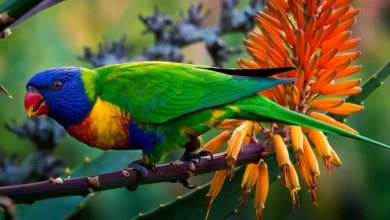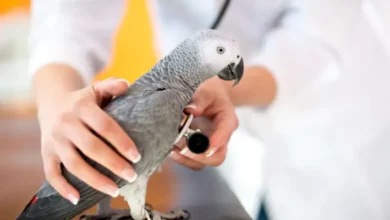The Wonderful World of Parrot Varieties
Parrots are one of the most diverse and captivating groups of birds. Their vibrant colors, intelligent behavior, and unique ability to mimic human speech have made them popular pets and fascinating subjects for bird enthusiasts.
This comprehensive guide explores various parrot species, detailing their characteristics, natural habitats, and care requirements. Let’s dive into the colorful and intriguing world of parrots.

Introduction to Parrots
Parrots, belonging to the order Psittaciformes, are known for their curved beaks and zygodactyl feet, which means they have two toes pointing forward and two backward. This adaptation helps them climb and grasp objects efficiently. Parrots are highly social and intelligent birds, capable of forming strong bonds with humans and other animals.
Popular Parrot Varieties
African Grey Parrot

The African Grey Parrot (Psittacus erithacus) is renowned for its exceptional intelligence and ability to mimic human speech. Native to the rainforests of West and Central Africa, these parrots are medium-sized, with a predominantly grey plumage and a striking red tail.
- Lifespan: 40-60 years
- Diet: Fruits, nuts, seeds, and vegetables
- Personality: Highly intelligent, social, and affectionate
- Care Level: Requires significant mental stimulation and social interaction
Macaws
Macaws are among the largest and most colorful parrots, native to Central and South America. Their long tails and vibrant plumage make them easily recognizable. Popular species include the Blue-and-Yellow Macaw (Ara ararauna), the Scarlet Macaw (Ara macao), and the Green-winged Macaw (Ara chloropterus).
- Lifespan: 50-80 years
- Diet: Fruits, nuts, seeds, and vegetables
- Personality: Social, intelligent, and playful
- Care Level: Requires ample space and enrichment activities
Cockatoos

Cockatoos are known for their expressive crests and friendly nature. Native to Australia and Indonesia, these parrots come in various species, such as the Sulphur-crested Cockatoo (Cacatua galerita) and the Moluccan Cockatoo (Cacatua moluccensis).
- Lifespan: 40-70 years
- Diet: Fruits, seeds, nuts, and vegetables
- Personality: Affectionate, social, and loud
- Care Level: Needs plenty of attention and mental stimulation
Amazon Parrots

Amazon Parrots are medium-sized birds native to the Americas, known for their vivid green plumage and vocal abilities. Species like the Yellow-naped Amazon (Amazona auropalliata) and the Blue-fronted Amazon (Amazona aestiva) are popular pets.
- Lifespan: 40-60 years
- Diet: Fruits, seeds, nuts, and vegetables
- Personality: Intelligent, playful, and social
- Care Level: Requires social interaction and mental enrichment
Conures
Conures are small to medium-sized parrots from Central and South America. Known for their playful and affectionate nature, conures include species such as the Sun Conure (Aratinga solstitialis) and the Green-cheeked Conure (Pyrrhura molinae).
- Lifespan: 20-30 years
- Diet: Fruits, seeds, nuts, and vegetables
- Personality: Energetic, playful, and affectionate
- Care Level: Needs plenty of social interaction and stimulation
Lovebirds
Lovebirds are small parrots native to Africa, known for their strong pair bonds and colorful plumage. Popular species include the Peach-faced Lovebird (Agapornis roseicollis) and the Fischer’s Lovebird (Agapornis fischeri).
- Lifespan: 10-15 years
- Diet: Fruits, seeds, nuts, and vegetables
- Personality: Affectionate, social, and playful
- Care Level: Requires social interaction and mental stimulation
Parakeets
Parakeets, or Budgerigars (Melopsittacus undulatus), are small parrots from Australia. These birds are highly popular pets due to their friendly nature and ability to mimic speech.
- Lifespan: 5-10 years
- Diet: Seeds, fruits, and vegetables
- Personality: Friendly, social, and active
- Care Level: Easy to care for, but needs social interaction
Eclectus Parrots
The Eclectus Parrot (Eclectus roratus) is known for its sexually dimorphic coloration, with males displaying bright green plumage and females showcasing vibrant red and purple feathers. These parrots are native to the Solomon Islands, New Guinea, and nearby islands.
- Lifespan: 30-50 years
- Diet: Fruits, seeds, nuts, and vegetables
- Personality: Calm, intelligent, and social
- Care Level: Requires a balanced diet and social interaction
Pionus Parrots
Pionus Parrots are medium-sized birds from Central and South America, known for their gentle disposition and quiet nature. Species such as the Blue-headed Pionus (Pionus menstruus) and the Maximilian’s Pionus (Pionus maximiliani) are popular choices.
- Lifespan: 25-40 years
- Diet: Fruits, seeds, nuts, and vegetables
- Personality: Calm, gentle, and social
- Care Level: Requires social interaction and a balanced diet
Parrot Care Essentials
Diet and Nutrition
Parrots require a balanced diet to maintain their health and vibrant plumage. A typical parrot diet includes a mix of fruits, vegetables, seeds, and nuts. Fresh fruits and vegetables should make up a significant portion of their diet, providing essential vitamins and minerals. Seeds and nuts should be given in moderation due to their high fat content.
- Fruits: Apples, bananas, berries, citrus fruits, and melons
- Vegetables: Leafy greens, carrots, bell peppers, and broccoli
- Seeds and Nuts: Sunflower seeds, pumpkin seeds, almonds, and walnuts
It’s crucial to avoid feeding parrots avocado, chocolate, caffeine, and alcohol, as these can be toxic to them.
Housing and Environment
Providing a suitable living environment is essential for a parrot’s well-being. The cage should be spacious enough for the parrot to move freely, with plenty of perches, toys, and activities to keep them entertained.
- Cage Size: The larger, the better, to allow for natural movements
- Perches: Varied sizes and textures to promote foot health
- Toys: Foraging toys, chew toys, and puzzles to stimulate their minds
- Lighting: Natural sunlight or full-spectrum lighting to support their circadian rhythms
Health and Veterinary Care
Regular veterinary check-ups are crucial for maintaining a parrot’s health. Parrots are susceptible to various diseases, such as psittacosis, beak and feather disease, and respiratory infections. Observing your parrot for signs of illness, such as changes in behavior, appetite, or droppings, can help catch problems early.
- Annual Check-ups: Regular visits to an avian veterinarian
- Grooming: Regular nail and beak trimming, as well as bathing
- Observation: Monitoring for signs of illness or distress
Parrot Training and Socialization

Training and socialization are essential for a parrot’s mental and emotional health. Positive reinforcement techniques can be used to teach parrots basic commands, tricks, and good behavior. Social interaction is also crucial, as parrots are highly social creatures that thrive on interaction with their human companions and other birds.
- Training Techniques: Clicker training, reward-based training
- Socialization: Regular interaction, playtime, and social bonding
- Behavioral Issues: Addressing biting, screaming, and feather plucking
Basic Commands and Tricks
Training your parrot to respond to basic commands can enhance your relationship and provide mental stimulation for your bird. Start with simple commands like «step up,» «step down,» and «come here.» Use treats and praise to reward your parrot for following commands. Gradually introduce more complex tricks, such as wave, turn around, and fetch.
Enrichment Activities
Providing enrichment activities is vital for keeping your parrot engaged and preventing boredom. Rotate toys regularly to keep your parrot interested, and incorporate foraging
activities where they can search for hidden treats. Puzzle toys, ropes, and climbing structures can also provide physical and mental stimulation.
Addressing Behavioral Issues
Parrots may develop behavioral issues like biting, screaming, or feather plucking if they are bored or stressed. It’s important to identify the underlying cause of these behaviors and address them promptly. Increasing social interaction, providing more toys, and creating a predictable routine can help reduce stress and improve your parrot’s behavior.

Understanding the different varieties of parrots and their specific needs is crucial for providing the best care possible. Each parrot species has unique characteristics, dietary requirements, and social behaviors. By learning about these fascinating birds and meeting their needs, you can ensure a happy and healthy life for your feathered companion.
Seasonal Care Guide
Here’s a handy seasonal guide to help you manage your parrot care throughout the year:
| Month | Diet Adjustment | Health Check | Grooming | Training | Social Interaction |
|---|---|---|---|---|---|
| January | More fruits | Yes | Beak trimming | Basic commands | Increased playtime |
| February | Balanced diet | Nail trimming | Step up/down | ||
| March | Fresh vegetables | Yes | Recall training | Regular interaction | |
| April | Seeds/nuts | Beak trimming | Tricks | Outdoor time | |
| May | More greens | Yes | Nail trimming | Fetch | Social bonding |
| June | Balanced diet | Wave | Regular interaction | ||
| July | Fresh fruits | Yes | Beak trimming | Turn around | Increased playtime |
| August | Vegetables | Nail trimming | Tricks | ||
| September | Seeds/nuts | Yes | Recall training | Social bonding | |
| October | More greens | Beak trimming | Step up/down | Regular interaction | |
| November | Balanced diet | Yes | Nail trimming | Basic commands | Outdoor time |
| December | Fresh fruits | Tricks | Increased playtime |
By following this guide and understanding the unique needs of your parrot, you can ensure they lead a fulfilling and healthy life. Parrots are incredible companions that require dedication and care, but the rewards of their companionship and the joy they bring are immeasurable.





